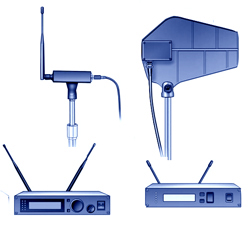Since the “paddle” or “shark fin” directional antennas for wireless systems (actually called LPDA or Log Periodic Dipole Array) are often seen at major events, it’s easy to conclude that such devices are always better and should be used for your church wireless system.
However, directional antennas aren’t always best for every application. Related to this, there is the misconception that putting the antennas closer to the transmitters is a good thing, even if your receivers are far away and connected with coax cable.
Further, the term “diversity” is often used and misused to describe certain types of receivers.
Let’s get these things out on the table and explained.
Cable Loss
First, be aware that if you are connecting antennas to your receivers with coax cable, there will be some signal loss. The amount of loss is related to the operating frequency, with higher frequencies exhibiting greater loss through the cable.
Table 1 shows the different types of cable and the loss per 100 feet at 700 MHz operating frequency. Note for U.S. wireless users – 698 MHz is now the upper limit of the standard UHF frequencies.
Thus, losses for frequencies between 470 – 698 MHz are less than these figures. But the concept still applies.
The last type shown in the list, Belden #9913F7, is a specialized, foam-dielectric cable that is fragile, fairly large in diameter, fairly expensive, and stiff. In other words, there are always trade-offs.
Generally, 50-ohm cable is typically used, but keep in mind that lower-loss 75-ohm cable can be a better choice in some applications.
To make up for signal loss, it may be necessary to use an in-line amplifier. Such devices require power, though. In general, the use of RF amplifiers is best reserved for larger systems where very long cable runs are needed.
Directional Antennas
As mentioned above, it may seem that directional antennas are always good. And in many cases, they are the right choice.
However, be aware that directional antennas have gain in one direction, and thus will pick up any signals coming from that direction, including those that you intend to pick up and those you don’t (such as DTV transmissions, etc.)
Thus placement becomes more critical. A dipole antenna will often do a better job for short range applications where a lot of movement is required on the part of the talent or a wide area needs coverage but not at a great distance.
Figure 1 (above) shows three antenna/cable scenarios and the results for each.






















